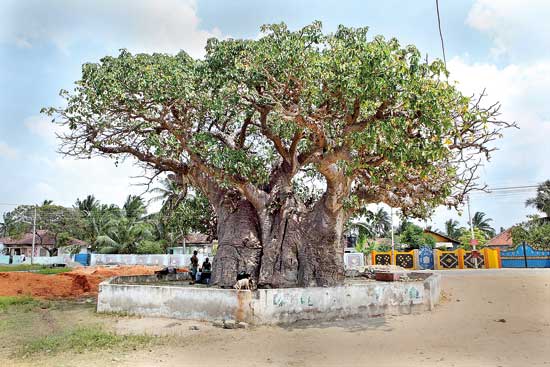Tales of the Baobab
Of all the introduced flora to Sri Lanka over centuries, probably the strangest and weirdest tree is the baobab. The baobab comes a close second to the Sacred Bo tree at Anuradhapura, in terms of maintaining records of its growth and status.
The baobab and its related eight species have their origins traced to Madagascar. In some remote geologic period, million of years ago, the fruits of one of the baobab species floated along the currents of the Indian Ocean and made landfall on the African coast. From here it was disbursed by human agency primarily by Arab migrants to the arid coastal lands of Africa, India and Sri Lanka.
The Arabs who were fine navigators and seamen were some of the first foreign visitors to arrive in Sri Lanka, centuries before the European maritime powers discovered the sea route around the Cape of Good Hope to India and Sri Lanka

Ancient Baobab tree in Pullimodai, Mannar. Pic by Luxshman Nadaraja
The Sinhala name for the baobab is Aliya gaha, denoting the characteristic texture and colour of the bark of the plant which to them resembled the skin of an elephant. The Tamil name for this tree is Perruku or Papparpuli, no doubt the Tamil prefix pulli namely for the tamarind fruit which the astringent tang of the baobab fruit resembles in flavour.
The ancient myths and legends associated with the baobab go back to the period when tree worship was prevalent and before established religions were practised.
One tale recounts that when all the animals in existence were given a specific tree of their own, the baobab was assigned to the hyena. Disgusted by its looks, the hyena turned the plant upside down and stuck it into the earth.
Another legend records that the first baobabs were extremely beautiful and far too proud of their beauty. The Gods punished its conceit and stuck it back into the ground upside down.
Another belief was that the baobab fruit was the original apple, the forbidden fruit of the biblical tale of Adam and Eve. It is also referred to as ‘Judas’ bag’ as it was said that Judas hung himself on the branches of the baobab tree.
In early Sri Lankan folklore, it was known as the Giant’s Tamarind and its fruit said to be eaten by the men who constructed the Giant’s Tank near Mannar, who were 40 cubits tall.
In India the early name for the baobab was Monkey’s Bread as it was believed to have been consumed by Hanuman’s army of monkeys.
The name baobab is from an African language corrupted from Arabic. Introduced to this island by Arab merchants who used to be part of the pearl fisheries from very early times, the fruits that had a splendid acid flavour were brought here largely for culinary purposes. Whether the trees were intentionally introduced or was it accidentally disbursed by seeds left behind in the camping sites is a matter for conjecture.
In the same vein, the name tamarind also has an Arab connotation and is derived from the Arabic words – Tamar i Hind which translated means the Date of India. Later it was corrupted to the English term for the fruit Tamarind.
The botanical and scientific term for the species is dansonia digitata and it has its roots going back almost three centuries, when the French traveller-naturalist and celebrated botanist Michael Adamson (1727-1806) first described the species to scientists in Europe. Adamson encountered the tree when he visited Senegal, during his exploration of West Africa in 1749.
The name was first recorded in ‘Historie Naturalle des Senegal’(1757) described as a fascinating work in which Adamson documented plants and animals never before seen by men of science in Europe.
The second part of the botanical name digitata refers to the arrangements of the leaf structure, similar to the fingers on a human hand. The prefix digitata is from the Latin derivative digitata or digitus – the finger.
In Pullimodai, Mannar, in the heart of the town stands one of the largest Baobab trees in existence and of which an old forester as far back in 1849, recounted a story frequently repeated:
”When I saw it in 1849, it had a hole almost a doorway on the northern side which one could enter to the inside of the tree (the hole is now fast closing up and one can only get one’s hand in now) which was like a small room sufficient to accommodate 8 or 10 persons, and it was a current tradition that some Portuguese ladies took refuge in at the Dutch conquest.”
This is a reference to the traditional belief in the Mannar area that Queen Dona Catherina fleeing to Mannar to find refuge from the Dutch forces was enclosed in the cavity of this tree.
Some of the earliest images we have of this giant specimen taken at Pullimodai was based on the photographs taken in the 1870s or 1880s by eminent photographer Joseph Lawton, better known for his views of the archaeological sites of Anuradhapura, Polonaruwa and Sigiriya.
According to measurements taken on July 17, 1895, the tree was 60 feet in girth and 35 ft. in height. In 2014 when I visited Mannar, according to the notice attached to the tree, it was said to be 64 feet in girth and 36 feet in height.
The other two trees lying a short distance from this site were said to be have been blown down during the heavy gale of 1814.
The two trees near the roadside along the seashore have a marvellous history. One is called Vellaty Perku, the other is known as the ‘lair of the cheetahs’.
The timber products extracted from the baobab are hardly used – as the wood is considered too soft, but the other uses such as its ability to store large amounts of water, some trees as much as 500 gallons, make it valuable especially for travellers seeking freshwater in an area which is frequently drought-ridden during long periods of the year.
At present, the baobab is found in scattered in small numbers on the island of Mannar and in Mantotte, also near Tiruketisvaram. One can guess that the Arabs may have visited Tiruketisvaram not for the purpose of worship but for trade.
Searching for an ideal partner? Find your soul mate on Hitad.lk, Sri Lanka's favourite marriage proposals page. With Hitad.lk matrimonial advertisements you have access to thousands of ads from potential suitors who are looking for someone just like you.


